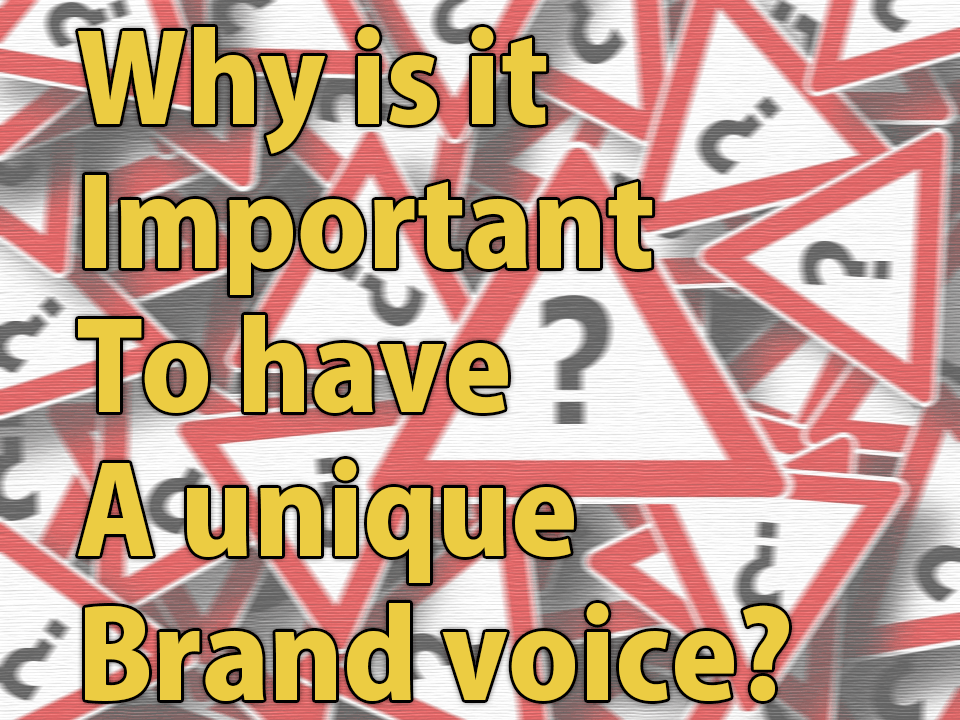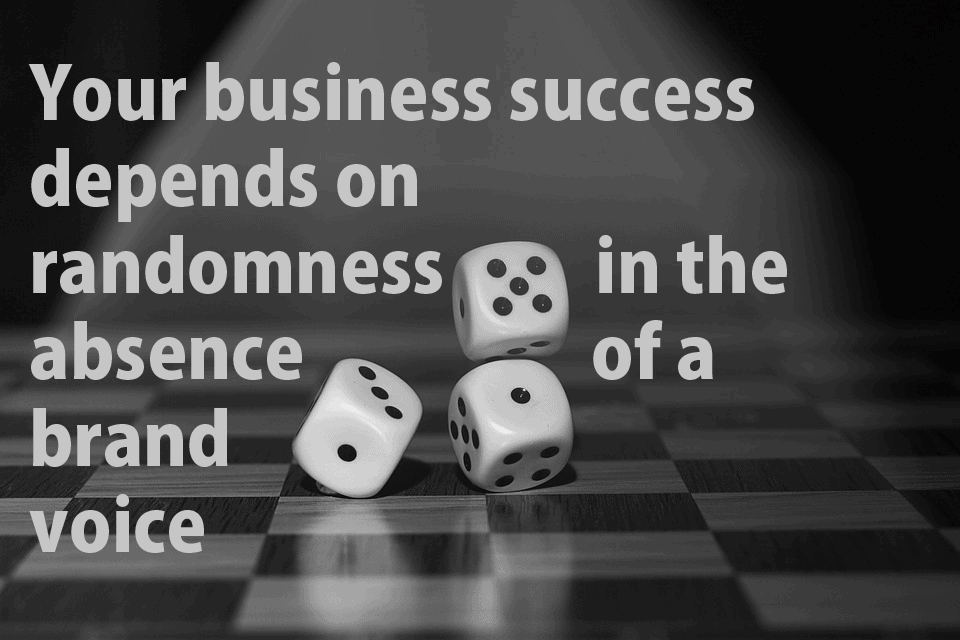A big part of promoting yourself on the web is developing and sustaining your brand voice and effective content writing can help you in this regard.
A unique brand voice is important to stand out. Your brand voice tells your audience what you stand for, what risks you can take to serve your customers and clients well, what drives you, and how confident you are.
Through your brand voice, even if you don’t mention your name, or your brand’s name, people can recognize, through your content writing, who you are.
Let me be frank here, this doesn’t happen overnight. Your brand voice doesn’t suddenly become known to your audience just after reading a few articles or blog posts from you. It may take months, or even 1-2 years for your brand voice to become recognizable.
What makes your brand voice recognizable?
- Constant exposure to your writing.
- Following a consistent standard in terms of writing quality and the relevance of the information and messaging being imparted.
- How many content distribution channels you can cover.
- Duration of your content marketing.
Why is it important to have a unique brand voice?
From your neighborhood vegetable seller to a busy executive sitting on the top floor of the World Trade Center, everyone can post content with minimum effort.
Whereas the Internet has pretty much democratized the degree of opportunity that everyone gets when it comes to promoting one’s business through content marketing and content writing, it also ends up creating lots of noise, and in fact, most of the content that you come across is noise or regurgitation.
No matter what search engines and social media websites claim, there is still a long way from distinguishing between high-quality content and mediocre content.
Sure, things have changed a lot in the past 15-20 years, but still, you can find lots of content constantly being highlighted by Google, Facebook, LinkedIn and Twitter, at the cost of ignoring the content that actually deserves to be highlighted.
I’m not saying your content doesn’t stand a chance. If it is high-quality content, if your content writing is relevant and provides solutions to people’s problems, then definitely it begins to appear in front of people – your target audience.
But how do they distinguish you from other businesses if there isn’t much difference between your content and their content.
Suppose you need a website content writer. You do a search on Google and find many links. You click them one by one and go through the information that is provided on these links.
If all the links sound similar, how do you decide?
The best you can do is, randomly decide on a certain content writer and then leave it on chance whether he or she (or the service) is going to deliver or not.
But what if I want to make sure that you go with my content writing service?
I provide you with something that you don’t find on the websites and blogs representing other content writing services?
Something to remember me. Something that makes you say, “Okay, this is something that I haven’t read anywhere else. This person sounds unique.”
This is the brand voice I’m talking about.
Further, ideally, if I publish my blog posts and articles somewhere else, you should be able to recognize that yes, it seems they have been written by Amrit.
If your business does not stand out through your unique brand voice, through unique content writing, your marketing messages get drowned under thousands of other marketing messages from other people even when they are not competing with you directly.
How to establish your unique brand voice through content writing?
You can establish your unique brand voice through multiple content formats, but since I provide content writing services, I’m going to talk about writing.
For long, I have had a knack for writing light-hearted, even bordering on humor, content.
Not every client appreciates humor and in fact, most of my clients want “professional” content using “impressive” words catering to their “core audience”.
At this phase of my life, it is not my purpose to educate my clients. It’s not that I don’t convey to them what I think how their content should be, but if they want to go on their own way, I don’t insist.
But there is this client who insists that the content on their website and on their blog must be funny and, easy-going.
My client knows that I can write such content.
My wife also knows it and for a couple of years, she has been insisting that I should change the content of my website to highlight this attribute.
Just as my client wants humorous content to be a part of her brand voice, my wife says that light-hearted content that makes people laugh, and also conveys my message convincingly, will work better. I agree.
So, how to find your unique brand voice?
Be comfortable under your skin
It’s very important that you are comfortable in who you are and what your business represents.
How do you get comfortable?
When you are confident of what you can deliver.
On my blog and on my website, I’m constantly talking about content writing, and sometimes content marketing. If I’m not confident, it will show through.
Ever noticed the body language of people who are trying to be something they are not? They stand with a strange posture. They walk in a strange manner. Even their voice sounds strange. Something is not natural about them and you want to interact with them as little as possible.
Something similar happens with your writing. If you are unnatural, if you pretend to be someone you are not, it comes through your words, your sentences and your paragraph.
To have a unique brand voice, become your true self.
Don’t be desperate
The purpose of writing content is, understandably, to get more business, and nobody in his or her right mind is going to resent you for that.
But earn the business, instead of constantly trying to grab it.
Convey to your prospective customers and clients what you can deliver and how you are already changing businesses and lives.
You may wonder why I’m giving the general business ethics advice instead of sticking to creating an effective brand voice through content writing.
It’s because, your brand confidence is directly related to what you achieve and what you deliver.
Anyway, the next step…
Decide whom you want to target through your content writing
This is very important before you can start defining you brand voice. It’s mostly your audience that decides what sort of content it wants to read on your website or blog.
These days I’m rapidly weeding out clients who want content just to improve their search engine rankings and otherwise, they couldn’t care less what sort of content their websites have.
In terms of work satisfaction and even in terms of getting paid, these are not good clients. In fact, they bring loss to my business by bringing my quality down and by having very little regard for what I’m writing for them (as long as I’m writing).
I’m looking for clients who know how important it is to have a unique voice and how important it is to inform their customers and clients of what they’re doing and how they are changing lives. I’m not going for numbers, I’m going for quality.
So, whenever I begin to change my brand voice, I’m going to keep this in mind. I’m going to target clients who are confident, clear-minded, and know the value of good content writing. This is going to have a big impact on my brand voice.
Look for a content writer who is going to stick
Remember that a good content writer is as important to your brand voice as the writing itself because when you change your content writer, your voice is going to change, no matter how hard you try not to change your voice.
Writing is not definitive. 20 logo designers can design the same logo with the same level of quality, but 20 content writers will write the same message in 20 different manners and consequently, your brand voice is going to come out differently.
Have a clear idea of how your brand voice is going to manifest through your content writing
Here is a nice tabular representation of how you should define your brand voice, but with my own input (source: Content Marketing Institute):
| Voice characteristic | Description | Do | Don’t |
| Passionate | You are passionate about how you change the world in general, and the lives of your customers and clients in particular | Share your wisdom and knowledge. Don’t sound insecure. Even share content from your competitors if it is good content. Acknowledge if you have done something wrong. | Use lots of fluff. Make unbelievable claims. Offend people just for the sake of offending. Use passive voice. |
| Quirky | You are not afraid of being yourself. You want to convey your message the way you want to convey it rather than getting bogged down by how you must sound. | Do the unexpected. Express a contrarian view. Be yourself without disrespecting others. | Use too many slangs and words just to impress your audience. Blow your own trumpet. |
| Irreverent (secondary characteristic of being quirky) | You take your product or service seriously. You take the stake of your customers and clients in your business seriously. But you don’t take yourself seriously. You can joke about yourself and you can let your hair down. | Use colourful language and graphics. Play around with different ideas to highlight your brand voice. Don’t shy away from entertaining your visitors. | Sound so casual that it seems you don’t care about your business and your customers and clients. Use too many words and expressions that, you may find amusing, but might be totally alien to a majority of your target audience. |
| Authentic | You offer something unique. You don’t hold yourself back when it comes to helping your prospective customers and clients even when it means there is a remote chance they’re going to buy from you. | Admit your mistakes and oversights. Be honest and direct. Assure your visitors that you’re always there in case there is a problem. | Use confusing language. Promise something you cannot deliver. Make tall claims. Promise the stars when you can’t even deliver flowers. |
Again, the above table may seem like it is a general business advice, but the way you do business has to be integral to your brand voice and how you write your content.
I know, whenever someone mentions “branding” it seems very markety and exotic, but it simply means, making yourself memorable and recognizable.
Once you have a brand voice, it must manifest through
- Your blog posts
- Your webpages
- Your social media updates
- Your email messages to your prospects as well as your current customers and clients
- Your daily communications
Your brand voice is basically your attitude. Let it manifest through every interaction that you have with your customers and clients.




